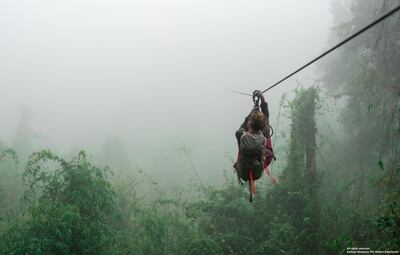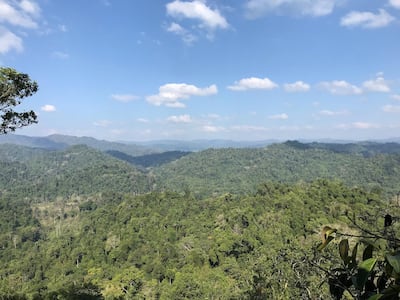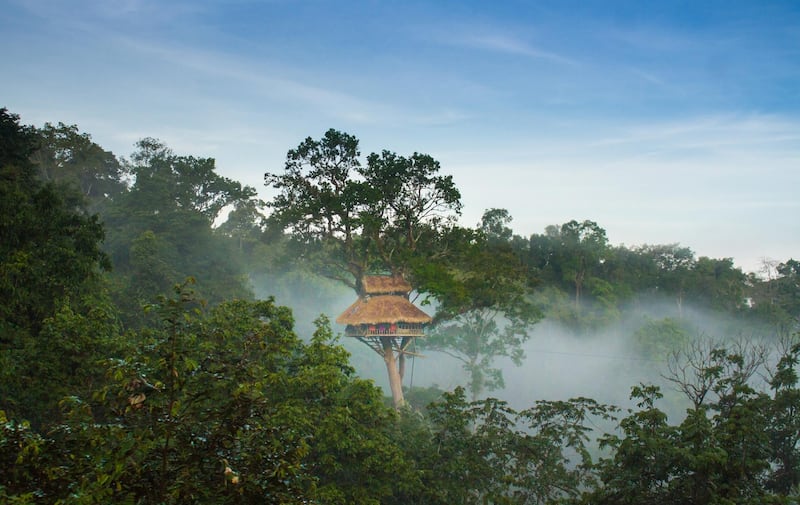Standing 30 metres to 50m above dense jungle in Laos's Nam Kan National Park – and traditionally only accessible to monkeys – these are the world's highest tree houses.
As part of the Gibbon Experience, adventurous travellers zip line their way through 15 kilometres of jungle canopy and, as the name suggests, the spectators of your feat will be hairier than average. The three-day, two-night escapade offers a bird's-eye view of the untouched jungle and its dense gibbon population, with a stay in some of the world's loftiest tree houses.
The canopy set-up serves as a unique nature observatory and every dirham of the money raised from the tourism project goes back into the conservation of the forest and our new friends that call it home. It's a worthwhile cause in the burgeoning field of ecotourism – plus there's the hair-raising elation that comes with the incredible zip lines and the glorious vistas of a misty rainforest that can be accessed in no other way.

Speaking of hair-raising, you may get your first pinpricks of fear before you’ve even left the ground. In Huay Xai province in northern Laos, I clamber into a ramshackle rickshaw, where excited faces quickly cloud over as we turn on to steep winding roads. After a two-hour bumpy ride, our dishevelled group arrives at our starting point, where we’re plied with steamed rice and veggies to sustain us for the exertion that lies ahead. That’s because the only way to get to the world’s highest tree houses is to head up through dense jungle. And the only way to tackle that is on foot.
Thankfully, the brisk trek to the first zip line only takes around an hour, and provides the first glimpse of the gorgeous jungle canopy sprawling beneath us. After a quick safety demonstration and a less than glamorous shuffle off the edge of a practice line, I arrive at the first 250-metre cable.
There’s no time to lose my nerve. Before there’s a chance to say “acrophobia”, I’m hooked up, taking a deep breath and plunging into the abyss 20 storeys above ground. I think of Tarzan and his flowing mane as he swings gracefully from vine to vine – before the force of the wind takes my breath away and my own tresses billow wildly. Next, an almighty rush of adrenalin hits my gut.
I realise that my eyes are shut. I force them open to bullfrog capacity, and my jaw simultaneously drops as though I'm catching flies. Agile ape man I am certainly not, but in true Tarzan style I let off a mighty howl that echoes through the treetops. The sheer scale of the beauty that surrounds me is astounding. And to witness it while roaring through the air at such speed is a blast like no other. All too soon I'm preparing for landing and scuttling on to the wooden ledge with trembling legs. But this is the first of many – across two days I will conquer up to 40 such journeys.
On day one, the group and I travel two hours by foot and cable to our home for the next two nights. The project’s eight tree houses are between 30 metres and 50 metres high and, as you might expect, only accessible by zip line. All are made with wood reclaimed from poachers and are equipped with electric solar lights. Our multistorey structure surrounds a magnificent ficus tree, complete with al fresco jungle bathroom and a dining terrace with panoramic views. Laos-style meals are cooked up in a neighbouring village and delivered to the tree houses by staff – via zip line, of course – along with fresh fruit and snacks.
Fed and watered, I bed down for the night. The futons are basic but comfortable, though the two-to-a-bed situation can be potentially awkward for solo travellers. Day two and I’m up with the larks, though it’s gibbons that I’m intent on seeing. We hear their soulful cries, but after decades of being hunted, these apes are masters of disguise, and remain under cover in the thick canopy.
Luckily, gibbons aren’t the only animals that call Nam Kan their home. There are also bears, pythons, pigs, deer and even leopards that roam among us in the 136,000-hectare jungle – as our group hangs over high ledges to catch a glimpse.
Our attempts are futile, but we’re pacified by a day of extreme zip-lining and intense hiking. We’ve selected the Classic tour, which is the best option for spotting gibbons. There’s also a Waterfall tour, which involves even more hiking, and an Express tour, which lasts for two days and one night.

You’ll need to be in good nick to take on any of these challenges. The path can be steep and the dozens of zip lines cover up to 500 metres at a time. It’s gruelling, but the huffing and puffing is made worthwhile by the sprawling forest beneath me, expanding as far as the eye can see. Our guides Thonghanh and Kurt are passionate about conservation and explain every last leaf and creature in the forest along the way.
As the trip comes to an end, I’m yet to lay eyes on a gibbon, but in some ways that makes my journey even more special. I’ve wandered through their home and heard their tuneful song – but this is no zoo. These majestic and critically endangered animals are free to roam here, without fear of being hunted or caged, and to be able experience their habitat, while playing a part in their conservation, is a privilege, whether we lay eyes on them or not.
It’s with this in mind that I unclip my harness on a high note, watched, I’m certain, by dozens of curious eyes that need never fear human interference again. To them, our presence has been inconsequential, and that’s the way it always should be.






